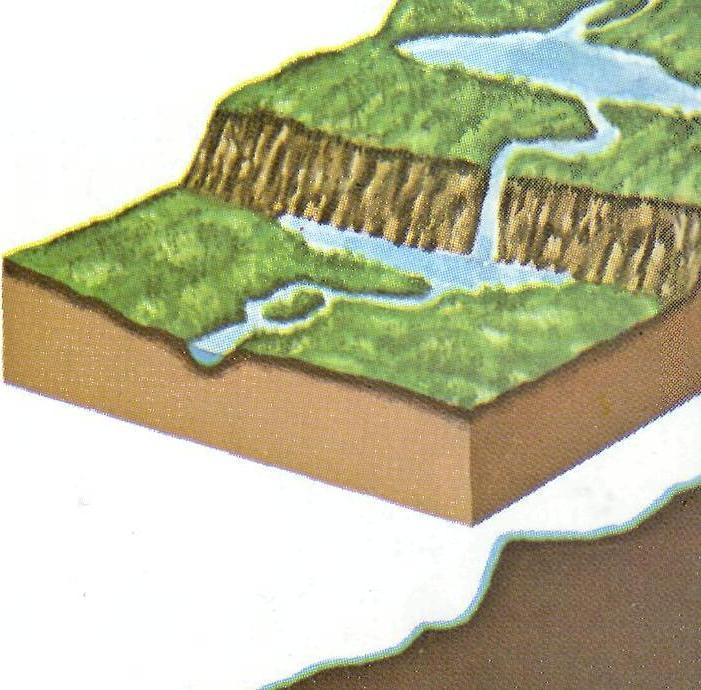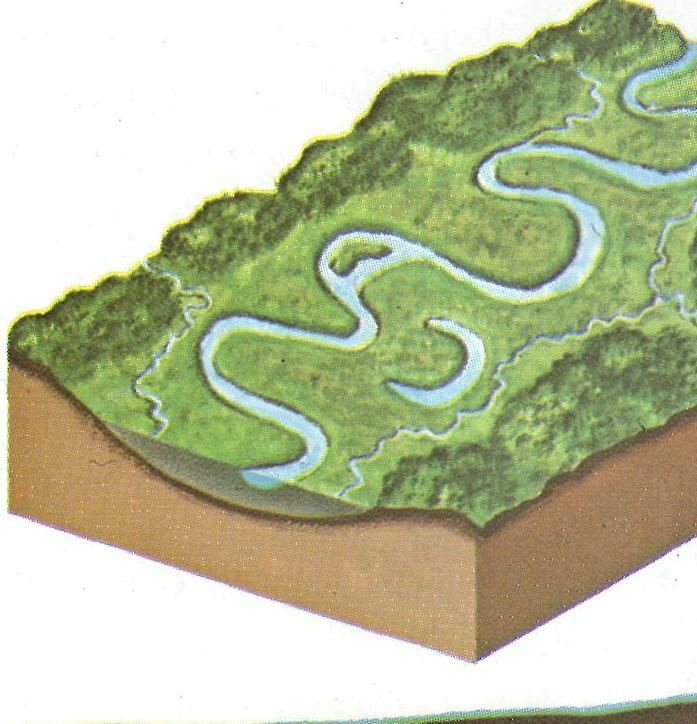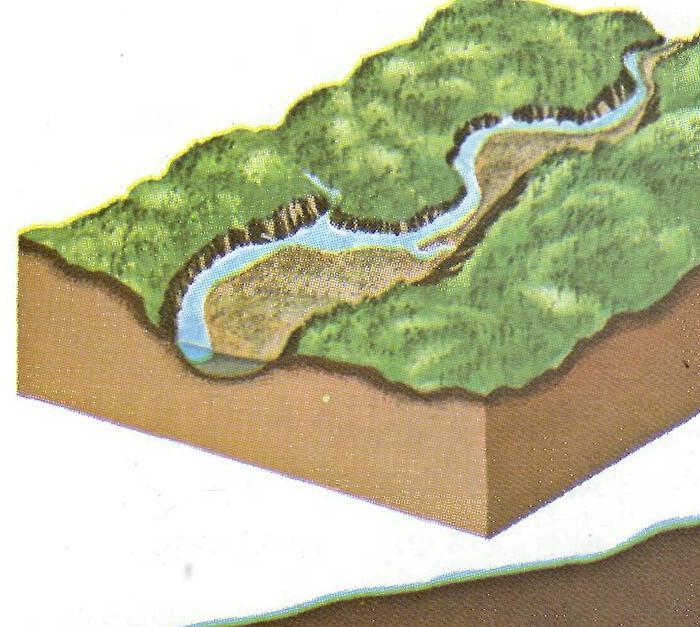
- •Part 1. Running Water
- •Vocabulary:
- •Running Water
- •The Hydrologic Cycle
- •The Form of Rivers
- •Dendritic Drainage Pattern
- •Part 2. River Profiles
- •Vocabulary:
- •River Profiles
- •1. Graded Profile 2. Smoother Steep Profile 3. Irregular Profile
- •Part 3. The Amazon River
- •Vocabulary:
- •Amazon River
- •Drainage Area
- •Origins
- •Flooding
- •Geography
- •1. What is anabranchs?
- •Tidal Bore (pororoca)
River Profiles
River Profiles reflect the varying development of drainage systems. During early development, changes are reflected by direction and shape of stream courses. Ultimately, erosion produces an equilibrium between the slope and volume of the river and its erosional and depositional power. This results in a graded profile, or profile of equilibrium. Final equilibrium is never reached because of seasonal and geologic changes. The downward limit of erosion by a river is the base level, below which the river cannot downcut appreciably because it has reached the level of the body of water into which it flows. Sea level is the ultimate base level for all rivers. Larger rivers and lakes into which rivers flow constitute local base levels.
Stages in the cycle of river erosion were once labeled as “youth,” “maturity,” and “old age.” Although these stages describe certain characteristics, they imply no particular age in years, only changing phases in development. Rivers often show a condition of old age near their mouths, but are mature or youthful in their higher reaches. For that reason, the terms are rather misleading, and are now rarely used.
Exercise 8. Separate the following text “River Profiles” into words and sentences and then read it and translate it into Russian:
Riverprofilesareinfluencedbygeologyandstructureoftheirdrainageareaandtendtoassumeagradedconcaveprofileastheyapproachequilibrium.
Exercise 9. Read the following texts and decide what of the titles below correspond to each of them:
Text A. It is common in upstream portions of rivers — shows high gradients, waterfalls, rapids, steep-sided valleys, irregular courses, few tributaries, and erosion. The Gunnison River in Colorado is an example.
Text B. It is steep, with high relief, but fewer irregularities. Erosion and transportation of underlying rocks gives wider valleys and smoother topography. Tributaries are well-established. The White River of southwestern Missouri shows these features.
Text C. It reflects deposition of transported load. The river flows sluggishly over a wide, flat flood plain, with meandering pattern, ox-bow lakes, and sand bars. This represents a baseline equilibrium between erosion by the river and deposition in the sea or lake into which it flows. The lower Mississippi and Amazon are examples.
Longitudinal profile
1. Graded Profile 2. Smoother Steep Profile 3. Irregular Profile



Part 3. The Amazon River
Study the list of vocabulary and pronounce the words after the teacher:
Vocabulary:
deliver [dɪ'lɪvə] v. – доставлять, разносить, развозить
watershed ['wɔːtəʃed] – водораздел; бассейн реки
handiwork ['hændɪwɜːk] – ручная работа; рукоделие; изделие, сделанное вручную; работа
gorge [gɔːʤ] – узкое ущелье, теснина; затор, нагромождение, завал
harness ['hɑːnɪs], ['hɑːnəs] v. – впрягать; запрягать; использовать (в определенных целях и по возможности полностью); приспосабливать
mouth [mauθ] – устье, вход
Venezuela [ˌvenɪ'zweɪlə] – Венесуэла
Khone Falls [kəun] – водопад Кэун
Mekong River [ˌmiː'kɔŋˌ ˌmeɪ'kɔːŋ] – Меконг (самая большая река полуострова Индокитай)
discharge [dɪs'ʧɑːʤ] v. – разгружать; выпускать (заряд, стрелу) , выстреливать; спускать, сливать; выливать
estuary ['estjuərɪ] – эстуарий, дельта; устье реки
dimension [daɪ'men(t)ʃ(ə)n] – измерение; pl. размеры, величина; объём; протяжение; размах, величина, степень, мера
bulk [bʌlk] – груда, кипа; масса; основная масса, большая часть (чего-л.); огромное большинство; величина, объём, масса
stretch [streʧ] – протяжённость; протяжение, простирание; пространство
stretch [streʧ] v. – протягиваться; простираться
remote [rɪ'məut] – расположенный на расстоянии друг от друга; дальний, далёкий, отдалённый
plume [plu:m] – спираль, струйка, струя, столбик (дыма); геол. столб магмы (поднимающейся с уровня нижней мантии до уровня литосферы)
dilute [daɪ'luːt] v. – разжижать, разбавлять
alter ['ɔːltə] v. – изменять; менять
protrude [prə'truːd] v. – высовываться, выдаваться
silt [sɪlt] – геол. ил, наносы, осадок; наносы ила
marginal ['mɑːʤɪn(ə)l] – граничный, приграничный, находящийся на краю
scanty ['skæntɪ] – недостаточный, ограниченный, скудный
confluence ['kɔnfluən(t)s] – слияние (рек) ; соединение (дорог); место слияния
terrain [tə'reɪn] – местность, территория, район; физические особенности местности; топография
cliff [klɪf] – отвесная скала на берегу моря; крутой склон, откос; холм; утёс
bluff [blʌf] – отвесная скала, крутой обрыв, утёс; отвесный берег
margin ['mɑːʤɪn] – кромка, край; приграничная область; берег
abutting [ə'bʌtiŋ] – граничащий (с прилегающим домом или участком земли)
bend [bend] (bent, bent) v. – сгибать; гнуть, изгибать
piranha [pɪ'rɑːnə] – зоол. пиранья (хищная рыба)
prey [preɪ] – добыча, предмет охоты, ловли
prey [preɪ] v. – ловить (кого-л., что-л.) , охотиться (на кого-л., что-л.)
otter ['ɔtə] – зоол. выдра
pose [pəuz] v. – позировать; представлять собой, являться
biodiversity [ˌbaɪəudaɪ'vɜːsɪtɪ] – биол. биоразнообразие, биологическое разнообразие
habitat ['hæbɪtæt] – биол. родина, место распространения, ареал (животного, растения)
seduce [sɪ'djuːs] v. – соблазнять; совращать; заманивать
maiden ['meɪd(ə)n] – дева, девица, девушка
herbivore ['hɜːbɪvɔː] – травоядное животное
weasel ['wiːz(ə)l] – зоол. ласка, горностай (и другие животные семейства куньих)
carnivorous [kɑː'nɪv(ə)rəs] – плотоядный
congregate ['kɔŋgrɪgeɪt] v. – собирать; собираться, скопляться, сходиться
school [skuːl] – стая, косяк (рыб или других морских обитателей)
livestock ['laɪvstɔk] – домашний скот
nostril ['nɔstr(ə)l] – ноздря
turtle ['tɜːtl] – зоол. черепаха
manatee[ˌmænə'tiː] – зоол. ламантин, морская корова
notorious [nəu'tɔːrɪəs] – знакомый, известный
mammal ['mæm(ə)l] – зоол. млекопитающее
reptile ['reptaɪl] – зоол. пресмыкающееся
camouflage ['kæməflɑːʒ] – камуфляж, маскировка
predator ['predətə] – зоол. хищник
specimen ['spesəmɪn] – экземпляр
immature [ˌɪmə'tjuə] – недоразвившийся, молодой
insect ['ɪnsekt] – зоол. насекомое
graduate ['grædjueɪt], ['græʤueɪt] v. – прогрессировать, изменяться
catfish [kætfɪʃ] – зоол. сом; зубатка; каракатица; головоногий моллюск
perch [pɜːʧ] – насест, жёрдочка (для птиц), ветка
tapir ['teɪpə] – зоол. тапир (a nocturnal hoofed mammal)
deer [dɪə] – зоол. pl. deer олень; лань
rodent ['rəud(ə)nt] – зоол. грызун
scaly ['skeɪlɪ] – чешуйчатый
Read and translate the definitions of the following words:
characin ['karəsɪn] – a small and brightly coloured freshwater fish native to Africa and tropical America
tucuxi [tʊ'kuːhi] – (same) a small stout-bodied dolphin with a grey back and pinkish underparts, living along the coasts and rivers from Panama to Brazil and in the Amazon
bull shark – large, stout-bodied aggressive shark. Its widespread distribution, its habits of feeding close to shore, and its tendency to venture far into estuaries and rivers makes it a species particularly dangerous to humans.
arapaima [ˌarə'pʌɪmə] – a very large edible freshwater fish native to tropical South America
caiman ['keɪmən] – (also cayman) a semiaquatic reptile similar to the alligator
capybara [ˌkapɪ'bɑːrə] – зоол. American mammal that resembles a giant long-legged guinea pig. It lives in groups near water and is the largest living rodent
Exercise 1. According to the following definitions guess the words from the list of vocabulary above:
Nouns:
1. fine sand, clay, or other material carried by running water; 2. a narrow valley between hills or mountains, typically with steep rocky walls; 3. the cattle and sheep which are kept on a farm; 4. a steep rock face, especially at the edge of the sea; 5. the place where two rivers join and become one larger river; 6. the place where a river starts; 7. the natural home or environment of an animal, plant, or other organism; 8. a stretch of land, especially with regard to its physical features; 9. the edge or border of something; 10. the stream of air, water, smoke, dust, or fire
Verbs:
1. to gather into a mass; 2. to extend beyond or above a surface; 3. to change or cause to change in character or composition; 4. to bring something to the proper address; 5. to shape or force something straight into a curve or angle; 6. to make a liquid thinner or weaker by adding water
Exercise 2. Read and translate the following expressions into Russian:
a total discharge; a broad estuary about 240 kilometres wide; the cleanest water sources in the world; extensive forested areas; an average dry season; a vast plume of freshwater into the ocean; sufficient wave & tidal energy; a glacial stream; the darkly colored waters; side by side without mixing; tributaries reaching into Venezuela, Colombia, Ecuador, and Bolivia; the average depth of the Amazon; connected by a complicated system of natural canals; table-topped hills extending for about 240 kilometres; 2 100 species of fish currently recognized; the main habitat of the Giant Otter
Exercise 3. Listen to the text “The Power of Flowing Water” and decide true or false are the following statements:
Statements:
1. The obvious reasons for the rivers are giving people and animals water to drink and fish to eat.
2. There is another force which changers the world’s surface more than running water.
3. The face of the earth could be completely eroded in 25 million years thanks to the rivers’ job.
4. Mature valleys are canyons and gorges.
5. Waterfall happens when a river wears away hard rock and then drops down onto soft rock that it can erode.
6. Some water falls are used for electricity production.
7. The tallest waterfall is in South America.
8. The Niagara is the mightiest of all Falls in the world.
Exercise 4. Listen to the text “The Power of Flowing Water” once again and answer the following questions:
Questions:
1. What are the major jobs of rivers?
2. When are valleys carved out?
3. What is the impressive bit of rivers’ handiwork?
4. What is the height of the tallest fall in the world?
5. What is Mekong River in Southeast Asia famous for?
6. Where is the longest river in the world?
7. Which river carries the most quantity of water in the world?
Exercise 5. Read the following text “Amazon River” and complete the sentences given below:
